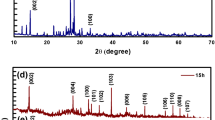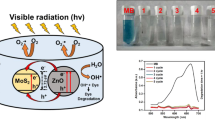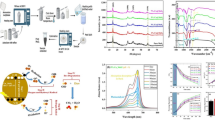Abstract
Cobalt concentrations of 7.5 and 10 wt% were incorporated in chemically exfoliated molybdenum disulfide (MoS2) nanosheets using hydrothermal route. Various characterization techniques were employed to evaluate the Co-doped MoS2 for structural, physiochemical, optical, and morphological properties. X-ray diffraction (XRD) technique confirmed the increase in crystallinity and crystallite size with doping ratios. The presence of functional groups and vibrational characteristic peak of Mo–O was determined using Fourier-transform infrared spectroscopy (FTIR). Field emission scanning electron microscope (FESEM) and high-resolution transmission electron microscope (HR-TEM) micrographs showed surface morphology and interlayer spacing. Absorption spectra and bandgap energy decreased with conjugation of Co ascribed to quantum confinement and edge effects as investigated using UV–visible spectroscopy. Thermal properties of prepared samples depicted weight and thermal stability as confirmed by differential scanning calorimeter and thermogravimetric analysis (DSC-TGA). Photoluminescence (PL) spectra confirmed the presence of doped species and revealed the growth of MoS2 monolayer. Dye degradation of doped and undoped MoS2 was tested in the presence of catalyst sodium borohydride (NaBH4) and it was observed that the methylene blue (MB) removal process increased with doping concentration. These nanocatalysts may prove useful in the removal of industrial contaminants, especially leather, and tanneries pollutants.









Similar content being viewed by others
References
Arshad A et al (2017) Solar light triggered catalytic performance of graphene-CuO nanocomposite for waste water treatment. Ceram Int 43(14):10654–10660
Bozheyev F, Valiev D, Nemkayeva R (2017) Pulsed cathodoluminescence and Raman spectra of MoS2 nanocrystals at different excitation electron energy densities and laser wavelengths. J Lumin 188:529–532
Chacko L, Rastogi PK, Aneesh PM (2019) Phase Engineering from 2H to 1T-MoS2 for efficient ammonia PL sensor and electrocatalyst for hydrogen evolution reaction. J Electrochem Soc 166(8):H263–H271
Cho MH, Ju J, Kim SJ, Jang H (2006) Tribological properties of solid lubricants (graphite, Sb2S3, MoS2) for automotive brake friction materials. Wear 260(7–8):855–860
Dervin S, Dionysiou DD, Pillai SC (2016) 2D nanostructures for water purification: graphene and beyond. Nanoscale 8(33):15115–15131
Feng G, Wei A, Zhao Y, Liu J (2015) Synthesis of flower-like MoS2 nanosheets microspheres by hydrothermal method. J Mater Sci Mater Electron 26(10):8160–8166
Gołasa K et al (2014) Multiphonon resonant Raman scattering in MoS2. Appl Phys Lett 104(9):092106
Haider A et al (2019) Enhanced bactericidal action and dye degradation of spicy roots’ extract-incorporated fine-tuned metal oxide nanoparticles. Appl Nanosci. https://doi.org/10.1007/s13204-019-01188-x
Junaid M et al (2019) The study of Fe-doped CdS nanoparticle-assisted photocatalytic degradation of organic dye in wastewater. Appl Nanosci 9:1593–1602
Kumar TN, Chandrasekaran N, Lakshminarasimha K (2012) Structural and electronic modification of MoS2 nanosheets using S-doped carbon for efficient electrocatalysis of hydrogen evolution reaction. Chem Commun 24:5
Kumar S, Sharma V, Bhattacharyya K, Krishnan V (2017) N-doped ZnO–MoS 2 binary heterojunctions: the dual role of 2D MoS 2 in the enhancement of photostability and photocatalytic activity under visible light irradiation for tetracycline degradation. Mater Chem Front 1(6):1093–1106
Kunduru KR, Nazarkovsky M, Farah S, Pawar RP, Basu A, Domb AJ (2017) “Nanotechnology for water purification: applications of nanotechnology methods in wastewater treatment”, in water purification. Elsevier, Amsterdam, pp 33–74
Li J et al (2017a) Ionic liquid assisted hydrothermal synthesis of MoS 2 double-shell polyhedral cages with enhanced catalytic hydrogenation activities. RSC Adv 7(38):23523–23529
Li B et al (2017b) Preparation of monolayer MoS2 quantum dots using temporally shaped femtosecond laser ablation of bulk MoS2 targets in water. Sci Rep 7(1):11182
Lin H et al (2017) Rapid and highly efficient chemical exfoliation of layered MoS2 and WS2. J Alloy Compd 699:222–229
Liu Y, Zhao Y, Jiao L, Chen J (2014) A graphene-like MoS2/graphene nano composite as a high performance anode for lithium ion batteries. J Mater Chem A 2(32):13109–13115
Ma L, Xu L, Xu X, Zhou X, Luo J, Zhang L (2016) Cobalt-doped edge-rich MoS2/nitrogenated graphene composite as an electrocatalyst for hydrogen evolution reaction. Mater Sci Eng B 212:30–38
Mao J, Wang Y, Zheng Z, Deng D (2018) The rise of two-dimensional MoS2 for catalysis. Front Phys 13(4):138118
Naz M, Haider A, Ikram M, Qureshi MZ, Ali S (2017) Green Synthesis ( A indica Seed Extract) of Silver Nanoparticles (Ag-NPs), Characterization, Their Catalytic and Bactericidal Action Potential. Nanosci Nanotechnol Lett 9(11):1649–1655
Nethravathi C, Prabhu J, Lakshmipriya S, Rajamathi M (2017) Magnetic co-doped MoS2 nanosheets for efficient catalysis of nitroarene reduction. ACS Omega 2(9):5891–5897
Oudeng G, Au M, Shi J, Wen C, Yang M (2018) One-step in situ detection of miRNA-21 expression in single cancer cells based on biofunctionalized MoS2 nanosheets. ACS Appl Mater Interfaces 10(1):350–360
Pandey A, Dutta S, Kumar A, Raman R, Kapoor AK, Muralidhran R (2016) Structural and optical properties of bulk MoS2 for 2D layer growth. AML 7(10):777–782
Peng H et al (2015) Co-doped MoS2 NPs with matched energy band and low overpotential high efficiently convert CO2 to methanol. Appl Surf Sci 353:1003–1012
Pineda-León HA et al (2018) Synthesis and characterization of molibdenum sulfide nanoparticles by a new chemical reaction formulation. Chalcogenide Lett 15:6
Placidi M et al (2015) Multiwavelength excitation Raman scattering analysis of bulk and two-dimensional MoS2: vibrational properties of atomically thin MoS2 layers. 2D Matter 2(3):035006
Rafiq A et al (2019) Photocatalytic and catalytic degradation of organic dye by uncapped and capped ZnS quantum dots. Mater Res Express 6(5):055801
Sim DM, Han HJ, Yim S, Choi M-J, Jeon J, Jung YS (2017) Long-term stable 2H-MoS2 dispersion: critical role of solvent for simultaneous phase restoration and surface functionalization of liquid-exfoliated MoS2. ACS Omega 2(8):4678–4687
Singh S et al (2019) Role of iron in the enhanced reactivity of pulverized red mud: analysis by Mössbauer spectroscopy and FTIR spectroscopy. Case Stud Constr Mater 11:e00266
Vattikuti SVP, Byon C (2015) Synthesis and characterization of molybdenum disulfide nanoflowers and nanosheets: nanotribology. J Nanomater 2015:1–11
Wahab A et al (2019) Dye degradation property of cobalt and manganese doped iron oxide nanoparticles. Appl Nanosci 9:1823–1832
Wang J et al (2016) Enhanced exfoliation effect of solid auxiliary agent on the synthesis of biofunctionalized MoS2 using grindstone chemistry. Part Part Syst Charact 33(11):825–832
Wang D, Xiao Y, Luo X, Wu Z, Wang Y-J, Fang B (2017) Swollen Ammoniated MoS2 with 1T/2H hybrid phases for high-rate electrochemical energy storage. ACS Sustain Chem Eng 5(3):2509–2515
Wang Z, Wu A, Colombi Ciacchi L, Wei G (2018) Recent advances in nanoporous membranes for water purification. Nanomaterial 8(2):65
Wang T et al (2018) Tulip-like MoS2 with single sheet tapered structure anchored on N-doped graphene substrates via C–O–Mo bonds for superior sodium storage. J Mater Sci 6:18
Windom BC, Sawyer WG, Hahn DW (2011) A Raman spectroscopic study of MoS2 and MoO3: applications to tribological systems. Tribol Lett 42(3):301–310
Wu J-Y, Lin M-N, Wang L-D, Zhang T (2014) Photoluminescence of MoS2 prepared by effective grinding-assisted sonication exfoliation. J Nanomater 2014:1–7
Wu Z et al (2015) Enhanced hydrogen evolution catalysis from osmotically swollen ammoniated MoS2. J Mater Chem A 3(24):13050–13056
Wu M, Li L, Liu N, Wang D, Xue Y, Tang L (2018) Molybdenum disulfide (MoS2) as a co-catalyst for photocatalytic degradation of organic contaminants: a review. Process Saf Environ Prot 118:40–58
Ye J, Chen W, Xu S, Yu Z, Hou S (2016) Synthesis of Co-doped MoS2/graphene hybrids as an enhanced electrocatalyst for hydrogen evolution reaction. RSC Adv 6:10
Yi M, Zhang C (2018) The synthesis of two-dimensional MoS2 nanosheets with enhanced tribological properties as oil additives. RSC Adv 8(17):9564–9573
Yin Z et al (2014) Au nanoparticle-modified MoS2 nanosheet-based photoelectrochemical cells for water splitting. Small 10(17):3537–3543
Yu H, Xu J, Guo H, Li Y, Liu Z, Jin Z (2017) Synergistic effect of rare earth metal Sm oxides and Co1–x S on sheet structure MoS2 for photocatalytic hydrogen evolution. RSC Adv 7(89):56417–56425
Zeng X, Niu L, Song L, Wang X, Shi X, Yan J (2015) Effect of polymer addition on the structure and hydrogen evolution reaction property of nanoflower-like molybdenum disulfide. Metals 5(4):1829–1844
Zhang X et al (2018) Photocatalytic activity of 3D flower-like MoS2 hemispheres. Mater Res Bull 100:249–253
Zhiming M (2013) MoS2. Springer, Berlin Heidelberg, New York
Acknowledgements
Authors are grateful to higher education commission (HEC), Pakistan for financial support through start research group (SRGP) project number 21-1669.
Author information
Authors and Affiliations
Corresponding author
Ethics declarations
Conflict of interest
Authors confirmed that this manuscript has no conflict of interest.
Rights and permissions
About this article
Cite this article
Raza, A., Ikram, M., Aqeel, M. et al. Enhanced industrial dye degradation using Co doped in chemically exfoliated MoS2 nanosheets. Appl Nanosci 10, 1535–1544 (2020). https://doi.org/10.1007/s13204-019-01239-3
Received:
Accepted:
Published:
Issue Date:
DOI: https://doi.org/10.1007/s13204-019-01239-3




